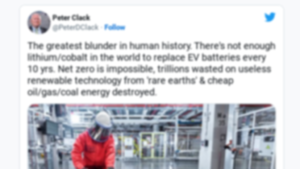Physical Address
23,24,25 & 26, 2nd Floor, Software Technology Park India, Opp: Garware Stadium,MIDC, Chikalthana, Aurangabad, Maharashtra – 431001 India
Physical Address
23,24,25 & 26, 2nd Floor, Software Technology Park India, Opp: Garware Stadium,MIDC, Chikalthana, Aurangabad, Maharashtra – 431001 India

CLAIM
There’s not enough lithium/cobalt in the world to replace EV batteries every 10 yrs. Net zero is impossible, trillions wasted on useless renewable technology from ‘rare earth’ & cheap oil/gas/coal energy destroyed.
FACT
Misleading Claim. There is enough Lithium reserve globally at present to fuel the conversion to EVs through to the mid-century. Alternative technology in terms of replacing Cobalt has already emerged. Battery recycling will also play a key role in the future.
WHAT THEY SAY
They claim that achieving net zero is impossible and one of the main reasons is the battery of the Electric Vehicle. They say that EV batteries are not sustainable in the long run as the world does not have enough minerals like lithium and cobalt that are used to make EV batteries. They further claim that renewable energy technology is useless and that oil, gas and coal energy are better and cheaper alternatives.
Here is one such social media post:
WHAT WE FOUND
We found that while it is true that, of late, a supply-demand imbalance has emerged in terms of lithium for EV batteries, the fact remains that this is happening because of the growing popularity of EVs and eventually as production ramps up, things will get smoother. It will also be misleading to declare this temporary shortfall as proof that there is not enough lithium/cobalt in the world for EV batteries and net zero is impossible.
Not negating that temporary shortage and dramatic price swings might occur in terms of the lithium for EV batteries, Haresh Kamath, a specialist in energy storage at the Electric Power Research Institute in Palo Alto, California, said that market hiccups will not change the picture in the long term.
“As more processing capacity is built, these shortages are likely to work themselves out,” said Kamath.
Enough Lithium to hit net zero
According to the Electric Vehicle Outlook 2022 report by BNEF, the current estimated global reserves of Lithium (21 million tonnes, according to the US Geological Survey) are enough to carry the conversion to EVs through to the mid-century.
It has been reliably calculated that global reserves are sufficient to produce just under 2.5 billion batteries and enough lithium was mined in 2021 to make just under 11.4 million EV batteries.
According to the IEA’s Net Zero by 2050 roadmap, ‘the world will need 2 billion battery electric, plug‐in hybrid and fuel-cell electric light‐duty vehicles on the road by that date to hit net zero’.
While it is true that all the world’s lithium cannot be used up in making EV batteries as the metal is also used for other items like laptops, mobiles, planes and trains, the fact remains that other alternatives like ‘reinvent and recycle’ are fast emerging to fill up those gaps.
Reinvent and Recycle
EVs still consist of a comparatively new market and new developments in terms of batteries, manufacturing methods and even mineral extraction from reserves are still happening and lie ahead in the future.
Reserves are the quantity of a resource that can be economically extracted under current market conditions, given available technology, and subject to applicable regulations. For the vast majority of resources, as demand rises, reserves eventually follow.
“Emerging technologies, such as direct lithium extraction or enhanced metal recovery from waste streams or low-grade ores, offer the potential for a step change in future supply volumes,” the IEA says in The Role of Critical Minerals in Clean Energy Transitions.
The IEA also says that beyond 2030, there will be an increase in the number of old EV batteries that have reached the end of their lives. Recycling them might reduce the demand for lithium by nearly a tenth by 2040, says the IEA. The World Economic Forum makes a similar forecast in its report, A Vision for a Sustainable Battery Value Chain in 2030.
Already transitioning away from Cobalt
While it is true that cobalt is a major component in lithium-ion EV batteries and it is more of a concern in terms of future availability, EV manufacturers are transitioning away from cobalt. Cobalt is being increasingly phased out in favor of better alternatives and other battery technologies that don’t use cobalt are emerging. Nickel-iron-aluminum cathodes or lithium-iron-phosphate batteries are being actively developed for use in new EVs.
Tesla’s current EV batteries contain less than 5% cobalt and as per a company announcement in September 2020, they are developing their own cobalt-free batteries. Others like General Motors (GM) too are significantly reducing the amount of cobalt in their batteries. GM recently unveiled a new battery system that uses 70% less cobalt than current batteries.
Most EV Batteries last more than 10 years
Most of the EV Batteries being used now will last more than 10 years and hence the claim that there will be a need to replace EV batteries every 10 years is misleading. Experts feel that the present EV batteries have a life expectancy of 15 to 20 years within the car and a second life beyond. They also said that EV battery technology is still evolving, so as technology develops lifespan of batteries will only increase in the near future.
Hans Eric Melin, managing director of Circular Energy Storage, a consulting company in London, said in an article published in Nature that in a typical electric car sold today, the battery pack will outlive the vehicle it was built into. He also said that ‘once millions of large batteries begin to reach the end of their lives, economies of scale will kick in and make recycling more efficient and the business case for it more attractive.’